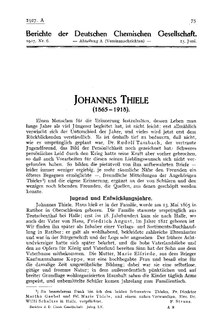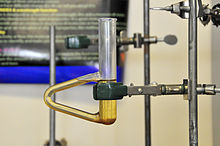Johannes Thiele (chemist)
Friedrich Karl Johannes Thiele (born May 13, 1865 in Ratibor , Upper Silesia , † April 17, 1918 in Strasbourg ) was a German chemist and university professor .

Life
Johannes Thiele was the son of a bookseller. He studied at the University of Breslau , first mathematics for teaching and moved in 1884 to the Friedrichs University Halle to study chemistry. There he became an assistant at the chemical institute in 1886, in 1890 he received his doctorate with Jacob Volhard with an analytical thesis ( on the divorce and determination of antimony ) and also obtained his habilitation there in 1892 ( on nitro and amidoguanidine ). In Halle he worked on hydrazines, among other things .
Thiele was 1893 Associate Professor of Organic Chemistry at the University of Munich at the invitation of Adolf von Baeyer as the successor of the ETH Zurich exchanged Eugen Bamberger . The future Nobel Prize winner Eduard Buchner had hoped for this extraordinary position in Munich.
In 1902 he became a full professor of organic chemistry at the Kaiser Wilhelms University of Strasbourg (successor to Rudolph Fittig ). Among his students were Otto Dimroth , Heinrich Wieland and Alfred Reis , who did their doctorate with him until 1909 . Hermann Staudinger worked as an assistant with Thiele in Strasbourg until 1907.
In the war year 1917 he and five other chemists were brought in by Fritz Haber for research on the use of gas at the Kaiser Wilhelm Foundation for Science of Warfare. On April 17, 1918, he died of heart disease.
In 1918, after losing World War I , the German University of Strasbourg became French again and its former employees had to leave the university. Heinrich Wieland had already hesitated before, in view of the looming defeat, to accept the offer of July 18, 1918 to succeed J. Thiele.
In 1902 he was accepted as a corresponding member of the Bavarian Academy of Sciences . In 1910 Thiele was elected a member of the Leopoldina .
plant
Among other things, Thiele researched the chemistry of various nitrogen compounds and oxidation reactions of organic compounds. His work on the properties of conjugated double bonds aroused great interest. The experimental investigations led him to develop a model to explain the 1,4-addition to conjugate double bonds, the theory (better hypothesis) of partial valences ( Thiele's theory , 1899). This happened at the suggestion of Adolf von Baeyer in Munich, where Thiele discovered the reduction of muconic acid to dihydric acid which was theoretically inexplicable at the time .
In studies of the reactions of cyclopentadiene, Thiele discovered a new class of compounds, the fulvene . A conversion of quinones into benzene derivatives bears his name: Thiele-Winter reaction .
He worked on the synthesis of azomethane (1909), nitrourea , nitramide , semicarbazide and fulvenes . In 1911, Thiele was among the first to postulate a linear structure for diazomethane - contrary to the then prevailing opinion of a ring structure. This structure could not be definitively proven until 1963.
The well-known apparatus for determining the melting point according to Thiele and the advance according to Anschütz-Thiele are still used today. According to him, Thiele's reagent for the detection of selenium named and for him and Marcelin Berthelot the Berthelot-Thiele reagent, an ammoniacal silver nitrate solution which is black in the presence of carbon monoxide färbt.1
Fonts
- with Henry Lord Wheeler: rearrangement of hydrazines into p-diamines. Munich 1889.
- Analytical contributions to the knowledge of antimony and arsenic. Doctoral thesis , CA Kaemmerer & Co., Halle 1890.
- About nitro and amidoguanidines. Habilitation thesis Halle, CF Winter, Leipzig 1892.
- About the spatial interpretation of the partial valences. In: Justus Liebig's Annals of Chemistry . Volumes 311–312, Leipzig 1900, pp. 241–255.
- Pure and technical chemistry. Speech to celebrate the birthday of Sr. Majesty the Emperor on January 27, 1904 in the auditorium of the Kaiser-Wilhelms-Universität Strasbourg.
- About the course of chemical reactions. Speech given at the foundation festival of the Kaiser Wilhelms-Universität on April 30, 1910 by the current Rector, Dr. Johannes Thiele. Strasbourg 1911.
Literature (chronological)
- Emil Knoevenagel : Thiele's theory of partial valences in the light of stereochemistry. In: Justus Liebig's Annals of Chemistry. Volume 311-312, Leipzig 1900, pp. 241-255.
- Ferdinand Heinrich: Thiele's hypothesis of the partial valences. In: Theories of Organic Chemistry. Friedrich Vieweg & Sohn Verlag, Braunschweig 1912, pp. 34–82.
- Journal of Applied Chemistry . Volume 31, Part 1, 1918, p. 117.
- H. Wichelhaus: meeting on May 13th. 1918 . In: Reports of the German Chemical Society . tape 51 , no. 1 , 1918, p. 878–882 , doi : 10.1002 / cber.191805101107 (obituary).
- Wilhelm Prandtl: The history of the chemical laboratory of the Bavarian Academy of Sciences in Munich. Munich 1952, p. 87.
- WR Pötsch, A. Fischer, W. Müller, H. Cassebaum: Lexicon of important chemists . 1st edition, p. 420, VEB Bibliographisches Institut Leipzig, Leipzig 1988, p. 420.
- Walther Killy , Rudolf Vierhaus (ed.): German Biographical Encyclopedia . Volume 10, KG Saur Verlag, Munich 1999, ISBN 3-598-23170-9 , p. 3.
Web links
- Literature by and about Johannes Thiele in the catalog of the German National Library
- Life data, publications and academic family tree of Johannes Thiele at academictree.org
Individual evidence
- ↑ Johannes Thiele: On the separation and determination of the antimony . In: Justus Liebig's Annals of Chemistry . tape 263 , no. 3 . CF Winter, Leipzig and Heidelberg 1891, p. 361-376 , doi : 10.1002 / jlac.18912630312 .
- ↑ Johannes Thiele: About nitro and amidoguanidine . In: A. Kekulé, E. Erlenmeyer, J. Volhard (Eds.): Justus Liebig's Annalen der Chemie . tape 270 , no. 1-2 . CF Winter, Leipzig and Heidelberg 1892, p. 1-63 , doi : 10.1002 / jlac.18922700102 .
- ↑ Johannes Thiele: About nitro and amidoguanidine . In: Chemisches Centralblatt . Complete revision course for ... band 63 , no. 10 . Leopold Voss, Hamburg and Leipzig September 6, 1892, Organic Chemistry, p. 402-403 ( online from Internet Archive [accessed March 2, 2016]).
- ↑ B. Witkop: Principiis obsta: Memories of Heinrich Wieland. (PDF; 4.7 MB) In: Chemistry in Our Time. 1977, pp. 143-149.
- ↑ H. Krauch, W. Kunz: reactions of organic chemistry. 5th edition (edited by W. Kunz and E. Nonnenmacher), p. 270, Hüthig, Heidelberg 1976.
- ↑ Johannes Thiele: About the constitution of the aliphatic diazo compounds and hydrazoic acid . Received on August 1, 1911. In: Reports of the German Chemical Society . tape 44 , 3, July – December, 1911, pp. 2522-2525 , doi : 10.1002 / cber.19110440376 .
- ↑ Johannes Thiele: A new apparatus for determining the melting point . Received: February 27, 1907. In: Reports of the German Chemical Society . tape 40 , January 1 – February, 1907, ISSN 0365-9496 , pp. 996-997 , doi : 10.1002 / cber.190704001148 .
- ↑ Alexander Senning: Elsevier's Dictionary of Chemoetymology The Whys and Whences of Chemical Nomenclature and Terminology . Elsevier, 2006, ISBN 978-0-08-048881-3 , p. 45.
| personal data | |
|---|---|
| SURNAME | Thiele, Johannes |
| ALTERNATIVE NAMES | Thiele, Friedrich Karl Johannes (full name) |
| BRIEF DESCRIPTION | German chemist and university professor |
| DATE OF BIRTH | May 13, 1865 |
| PLACE OF BIRTH | Ratibor , Upper Silesia |
| DATE OF DEATH | April 17, 1918 |
| Place of death | Strasbourg |


